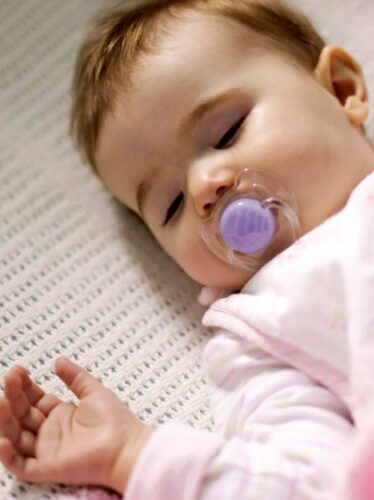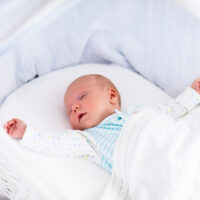While there is a convenience to having your sweet bundle of joy sleeping nearby, many parents reach a point where they want to banish the bassinet from their bedroom.
This is an extremely personal decision that you and your spouse will have to make, but there are a few things to consider before you expedite the move to a crib.
Six Tips For Transitioning Your Baby To Their Crib
Consider Recommended Sleeping Arrangements
The American Academy of Pediatrics recommends that babies sleep in the same room as their parents for at least the first six months of life, but preferably up until their first birthday.
While this can seem a bit tedious over time, this guidance is in place for a very important reason. Each year, an average of 3,500 healthy children die from Sudden Infant Death Syndrome (SIDS). This condition usually comes on quickly while the baby is sleeping.
Doctors don’t know the exact cause, but it is theorized that by sleeping in the same room as mom and dad, the likelihood of this horrific situation can be decreased by up to 50%. Why? It is believed that if they have added background noise, it prevents them from truly falling into a deep sleep. Unlike a sound machine, the noises one makes in moments of slumber are sporadic and ever-changing. Moreover, this sleeping arrangement allows you to constantly monitor them throughout the night.
Other effective methods for preventing SIDS include having your baby sleep on a hard surface while on their back. Both a bassinet and a crib are suitable and safe options. Pacifier use and consistent breastfeeding are also advised.
Finally, overheating can be another potential trigger, so remember to keep their room between 68 to 72 degrees.
It is important to remember that even when implementing these alternative safety precautions, it is always best to wait until your little one’s half birthday to transition to the nursery.
Determine Baby’s Readiness for a Crib
Size and Weight
Bassinets tend to be quite snug in order to provide a convenient place for infants to sleep in their parent’s bedrooms. However, many moms and dads of bigger babies ponder moving them to the crib sooner. Most of these sleepers have a twenty-pound weight limit, but it can be as low as ten pounds. Always check the packaging to make sure that you stop use at the appropriate time.
In addition, some babies tend to squirm m0re than others. This can lead to them hitting the sides of their sleeper and waking up more frequently throughout the night. As the bassinet becomes less capable of being able to accommodate your little one, it is time to start planning a transition to the crib.
Milestones
Your baby’s first year will be filled with exciting moments. One big milestone is when they become are strong enough to flip over onto their tummy! This is one of your first clues that your baby is getting ready for their big boy bed! Most infants hit this mark right around six months, but there are a few overachievers who decide to showcase this skill a bit sooner.
Unfortunately, with these movements, the worry of the bassinet tipping over becomes more of a concern. This is especially true when their weight starts to approach the maximum capacity. This may warrant a quicker move to the crib, but depending on their age, you might have to locate a spot in your bedroom to place this piece of furniture.
This is because the real determinants of readiness are threefold. The first is flipping onto their tummy. However, they also need to be able to lift their head for extended periods of time and flip themselves BACK onto their back. Without these key skills, there is a major concern of airway obstruction and suffocation. Therefore, until you are confident that they execute these actions, it is best to flip them back over and keep them with you for a bit longer.
For the parents who want to expedite this venture, tummy time is a fantastic way to help them strengthen their shoulder and neck muscles. You can begin tummy time as early as two weeks of age. Start with thirty-second intervals two to three times daily. Then work up to longer and more frequent sessions until they are good to go!
Prepare a Safe Sleeping Space
Once they are ready for the big move, it is imperative that you make a safe space for their slumber. Here are the top things to consider when preparing their sleeping arrangements.
The Crib
All American and Canadian sold cribs are required to meet certain safety standards. Thus, you can spend $100 or $5,000 and the end result will be the same. However, it is imperative that you buy a new crib to ensure that these mandatory qualities are present in the design. Never purchase or accept a used crib, no matter how tempting it may be to save a little cash.
Moreover, when placing the crib in the room, make sure that it is located away from vents or heat sources. You also want to avoid windows with blinds, drapes or any type of window treatment. The pull cord and loose fabric can pose a strangulation threat as your child gets older. This also goes for any electrical cords like for a lamp, sound machine or baby monitor.
Additionally, while it can create the picture-perfect moment, you want to steer clear of having any toys, stuffed animals, blankets, bumpers or pillows in the crib. All of these items can serve as a suffocation hazard. Until your little one turns twelve months old, plain and simple is the safe bet.
The Crib Mattress
This is another item that should be new. Hand-me-downs should be avoided at all costs. Why, you ask? Over the first few years of their life, a baby will pee, poop, spit-up and drool all 0ver their mattress. Despite always having a bedsheet over it, as time progresses, this will lead to bacteria growth and mold development. Therefore, while the crib mattress may cost more than the actual crib, it is worth buying your own.
The two main features to look for are a firm mattress and a waterproof cover. The former ensures less of a chance of SIDS and the latter helps to prevent germs from setting up camp. The only other thing to note is that the mattress MUST fit in the crib. Buying something smaller than the allotted space serves as another safety issue.
Slowly Make the Move to the Crib
Whether you believe it or not, this transition is going to be jarring for both of you. Focus on facilitating a slow move in order to make the adjustment easier on everyone.
Establish a New Routine
This is their new safe space. You want the environment to welcoming and familiar to them. Therefore, before all nap times and bedtimes, spend time in their room. If you have a rocker or glider that you normally feed your baby in, consider moving it into the nursery. Then conduct all feedings that precede bedtimes in this chair.
Next, start using the crib at their nap time. As they start to drift off to sleep, gently lay them into their new bed and linger a little. Keep your hand on their back or belly until they seem comfortable and content. Knowing you are there can help in this transition. After a few weeks, then let them sleep in their room all of the time.
Give the Illusion of Nighttime
In order to get a good night’s rest, it is important to have a dark and relaxing environment. Purchase blackout curtains if the blinds are letting in too much light and use a sound machine to help create a calming space. Moreover, implement quiet time as you get them ready to rest.
Start the Move to a Crib In Your Bedroom
For the parents of early achievers as well as those babes who are fighting the change, starting with the crib in your room can make the move easier. This ensures that the only difference initially is the item that they are sleeping in. Once they become accustomed to the crib, then you can move it into the nursery.
Wait for a Consistent Time Frame
Moving your baby to the crib right before a trip or the holidays when their sleep schedule may be fluctuating is downright jarring. This will make the transition a whole lot harder. Holding off until a boring time when their schedule can stay intact is imperative for an easy move. Also, try to avoid times when they are teething or going through sleep regressions.
Patience can be difficult to come by when it comes to your baby’s sleep schedule being out of whack, but picking the right moment can make all the difference in the world. Repetition is key for babies, therefore timing is everything.
Work On Their Self-Soothing Skills
Unlike when they are located a few feet away from you, the moment your baby heads to the nursery, there might not be someone at their immediate beck and call. Therefore, working on their ability to self-soothe can save them the stress of waking up in a new environment. It will also save you a potential trek across the house.
When getting your baby ready for a nap or bedtime, don’t put them down after they are already asleep. Instead, get them into a groggy state and then slowly put them in the crib. After they settle into a comfortable position, slowly and quietly back away and close the door. If they start to cry, let them get it out. If they are tired enough, it should only take a few minutes for them to doze off!
However, if the crying goes on for more than five minutes, the Ferber Method instructs parents to go back into the room and check on them. If they are just being fussy, tell your baby “It’s okay” or “I love you” and then leave for another short period of time. The goal is to build up the number of minutes in between each re-entry into their room.
Something to note — the first time that you go back in the room, always remember to think about alternative reasons for the tears before continuing with the process. Are they wet? Hungry? Feeling warm? Teething? If you answer no to these questions, then stay strong with this technique. Over time, you will start to notice a difference, if you remain consistent.
Frequently Asked Questions — Your Baby’s Move To A Crib
What is the average age that a baby moves to a crib?
This milestone normally occurs between three to six months, but your baby’s movements and weight can also play a factor in the timing of this transition. However, if you decide to move your little one prior to the six-month mark, it is always best to still keep them in your room until at least their half birthday.
What is the earliest age that my baby can sleep in a crib?
If the crib is in your bedroom, then your baby can sleep in it from day one. As long as it is a firm mattress and a safe sleeping environment, you are good to go!
What if I don’t have room in the master bedroom for a crib?
If you don’t have space for the crib in your room, then it is best that you and your spouse take turns sleeping in the baby’s room. You can set up their big kid bed early for yourself or you can purchase a blow-up mattress. While inconvenient, their safety should be your number one prerogative.
Final Thoughts on Your Baby’s Move To A Crib
When transitioning your little one to their crib, it is important to consider their readiness and safety as well as the space that you have allotted in your bedroom. Many new parents just don’t have the room for a piece of furniture this size so you will likely have to get creative.
Most importantly, the key to a smooth transition from a bassinet or side sleeper to the crib is to make the move slowly and to keep to a schedule.
Finally, don’t forget to purchase a baby monitor to ensure that you can still keep a close eye on your sweet angel while they are afar!










